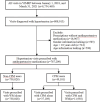Prescribing characteristics and guideline concordance of antihypertensive western and Chinese patent medicine in Internet hospitals in China: a cross-sectional study
- PMID: 40371350
- PMCID: PMC12076013
- DOI: 10.3389/fphar.2025.1580787
Prescribing characteristics and guideline concordance of antihypertensive western and Chinese patent medicine in Internet hospitals in China: a cross-sectional study
Abstract
Introduction: Internet hospitals have emerged as a vital approach for patients seeking treatment for hypertension, with a significant increase in antihypertensive medication prescriptions through these innovative models. However, prescribing characteristics and guideline concordance of these prescriptions remain unclear. This study aim to analyze the prescribing characteristics of Western medicine (WM) and Chinese patent medicine (CPM) for hypertension and assess their concordance with hypertension guidelines in Internet hospitals in China, providing insights for optimizing antihypertensive CPM management.
Methods: A cross-sectional analysis was conducted using data from the Yinchuan Internet Medical Regulatory Platform (YIMRP) covering 87 enterprise-led Internet hospitals in China from 1 January 2018, to 31 March 2021. Visits diagnosed with hypertension and prescribed at least one oral antihypertensive medication (either WM or CPM) were included. Guideline concordance was evaluated by comparing prescribed individual antihypertensive WM and CPM in Internet hospitals with international and Chinese hypertension guidelines recommendations. Statistical analyses included descriptive statistics, association rule analysis, and guideline concordance assessment.
Results: Among the 787,209 visits, 93.75% were prescribed WM alone, 4.72% CPM alone, and 1.52% a combination of CPM and WM. Calcium channel blockers (CCBs) (38.50%) was the most prescribed WM class, with nifedipine (19.67%) being the most common individual medication. Most prescriptions of antihypertensive WM were guideline-concordant. Among CPM prescriptions, only 181 (0.37%) included traditional Chinese medicine (TCM) syndrome diagnoses. Of the 38 prescribed antihypertensive CPM, only 7 were guideline-recommended. The most frequently prescribed CPM were Jiuqiang Naoliqing (17.67%), and Zhenju Jiangya tablet (14.74%), neither of which was recommended by the guidelines. The combinations of two CPM were frequently prescribed, but none of these combinations were recommended by guidelines. The most common dual CPM combination was Jiuqiang Naoliqing + Qiangli Dingxuan tablet/capsule (support 8.65%, confidence 0.44%).
Conclusion: The prescribing characteristics of antihypertensive WM in Internet hospitals closely align with those in offline hospitals with relatively satisfactory guideline concordance. However, some issues persist in antihypertensive CPM prescriptions, including the lack of TCM syndrome differentiation, frequent prescription of non-recommended CPM, and duplicate therapies. Strengthening CPM management in Internet hospitals is essential for optimizing hypertension care.
Keywords: Chinese patent medicine; Internet hospitals; Western medicine; guidelines concordance; hypertension; prescribing characteristics.
Copyright © 2025 Zhou, Liao, Zuo, Han, Meng, Zhuo, Liu and Hu.
Conflict of interest statement
Author GL was employed by Beijing PD Cloud medical Technology Co., Ltd. The remaining authors declare that the research was conducted in the absence of any commercial or financial relationships that could be construed as a potential conflict of interest.
Figures





Similar articles
-
Analysis of online prescription patterns in Chinese patients with sequelae of cerebral infarction: a real-world study.Sci Rep. 2024 May 25;14(1):11962. doi: 10.1038/s41598-024-62923-1. Sci Rep. 2024. PMID: 38796623 Free PMC article.
-
Chinese patent medicine combined with calcium channel blockers in the treatment of essential hypertension:a Bayes network meta-analysis and systematic review.Front Pharmacol. 2024 Mar 15;15:1321405. doi: 10.3389/fphar.2024.1321405. eCollection 2024. Front Pharmacol. 2024. PMID: 38560355 Free PMC article.
-
Expert consensus on the treatment of hypertension with chinese patent medicines.Evid Based Complement Alternat Med. 2013;2013:510146. doi: 10.1155/2013/510146. Epub 2013 Apr 3. Evid Based Complement Alternat Med. 2013. PMID: 23662141 Free PMC article.
-
[Network Meta-analysis of efficacy and safety of oral Chinese patent medicines combined with conventional western medicine in treatment of hypertension].Zhongguo Zhong Yao Za Zhi. 2022 Apr;47(7):1955-1988. doi: 10.19540/j.cnki.cjcmm.20211223.501. Zhongguo Zhong Yao Za Zhi. 2022. PMID: 35534266 Chinese.
-
Comparative efficacy of commercial oral poly-herbal traditional Chinese medicine formulations combined with western medicine in benign prostatic hyperplasia management: a systematic review and network meta-analysis.Front Pharmacol. 2024 Jun 5;15:1358340. doi: 10.3389/fphar.2024.1358340. eCollection 2024. Front Pharmacol. 2024. PMID: 38904002 Free PMC article.
References
-
- Alyabsi M., Gaid R., Alqunaibet A., Alaskar A., Mahmud A., Alghamdi J. (2020). Impact of the 2017 ACC/AHA guideline on the prevalence of elevated blood pressure and hypertension: a cross-sectional analysis of 10,799 individuals. BMJ Open 10 (12), e041973. 10.1136/bmjopen-2020-041973 - DOI - PMC - PubMed
-
- Chinese pharmacopoeia commission (2020). Chinese pharmacopoeia. Available online at: https://ydz.chp.orh.cn/#/main (Accessed December 19, 2022.
LinkOut - more resources
Full Text Sources

